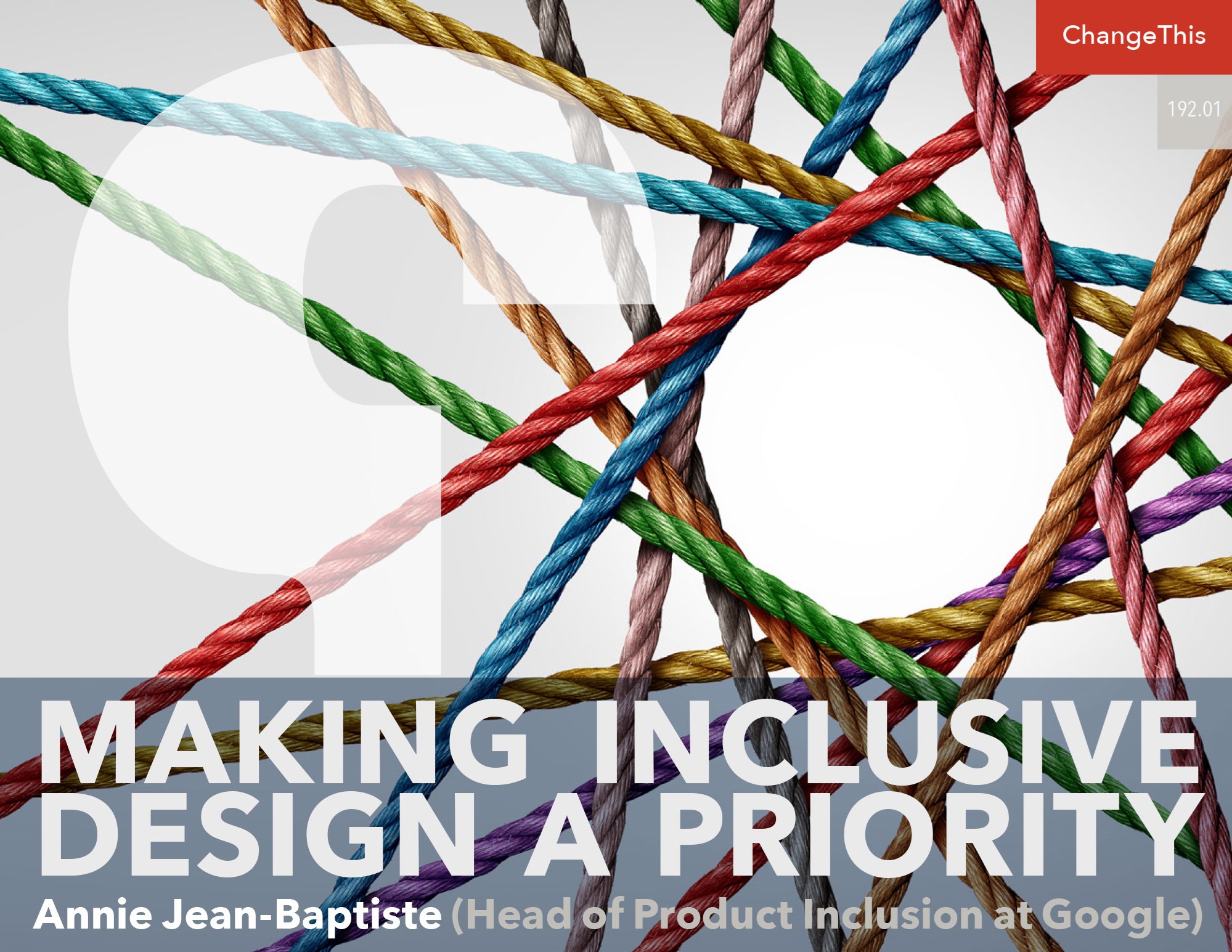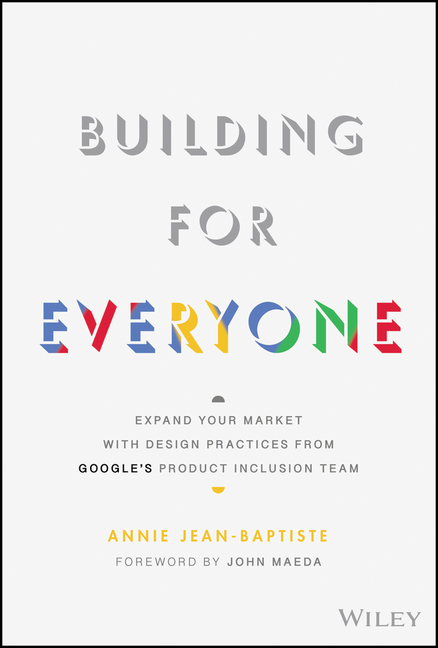Making Inclusive Design a Priority
September 09, 2020
As diversity and inclusion champion Joe Gerstandt reminds us, “If you do not intentionally, deliberately and proactively include, you will unintentionally exclude.” This phrase is often repeated at Google to remind our teams that merely wanting to do the right thing isn’t enough.
Think about a time when you felt completely yourself.
Maybe you were with family members or friends that completely accepted you, or you were performing a hobby that you enjoyed immensely and could lose yourself in. You felt at ease, almost blissful, void of judgment because you could shake any preconceived notions of who you are, who you are supposed to be … and just be.
Now, think about a time when you felt excluded or ignored. Have you ever shown up at a party, summer camp, or a new job only to discover that everyone had already made friends and wasn’t particularly welcoming or eager to get to know you? How did that make you feel? At the end of the day, everyone wants to feel welcome. It’s what people want in their relationships with their family members, their friends, their pets, and their colleagues.
When we don’t fit in or when products or services do not feel as though they were built for us, we feel excluded, frustrated, disappointed, or even upset. When a product or service seems to be designed for everyone but us, we can feel as though we were ignored or disregarded by those involved in the product design process. Our feelings can range from mere annoyance (“Whatever, I didn’t want to use this thing anyway”) to deep alienation or hurt (“I feel like this does not represent me or my community and what this represents is threatening”).
Knowing that we’ve all had an experience of being othered (marginalized by a social group that considers itself superior) regardless of our background, it’s imperative that we don’t create that feeling in people who interact with our products, services, content, marketing, or customer service. When creating products, we want to avoid building anything, even unintentionally, that makes anyone feel this way.
As designers, creators, engineers, user researchers, marketers, and innovators, we want everyone to feel included. Isn’t that why we got into this work—to be able to create products, services, and content that shape the world for the better, that empower people to live richer lives, to experience things they haven’t with the people (or creatures) they love? At the heart of this commitment is inclusion: everyone seeing themselves in the end result of a company’s or an individual’s work. People want to feel seen, heard, and considered; they want to feel that people like them matter to companies, that their unique backgrounds and perspectives are valued.
As diversity and inclusion champion Joe Gerstandt reminds us, “If you do not intentionally, deliberately and proactively include, you will unintentionally exclude.” This phrase is often repeated at Google to remind our teams that merely wanting to do the right thing isn’t enough.
As we plan for inclusion, following the golden rule—treating others as we would like to be treated—isn’t the way to go. We need to adopt the platinum rule—treating others as they would like to be treated. Brian Stevenson, Executive Director at the Equal Justice Initiative (EJI) and author of Just Mercy, encourages us to get “proximate.”
Getting proximate is the act of getting closer to someone, to understand their experiences, their fears, their hopes. The goal is to build empathy, which leads to action.
Although Stevenson discusses the need for empathy in a different context, this concept is very applicable to product inclusion as well. As a whole, businesses and other organizations haven’t been proximate with all consumers, including people of color, lower socioeconomic status, and advanced age; people who live in rural communities or outside the business’s home country; people with disabilities; and those who are members of the LGBTQ+community. When dimensions of diversity intersect (for example, a Black woman over 50), the challenge to serve consumers’ needs and preferences becomes even more nuanced. Becoming proximate enables you to understand, to build empathy, to want to be better, and to want to do better. It provides the drive to hold yourself, your teammates, and your organization’s leadership accountable to truly building for users regardless of their background.
MAKING INCLUSIVE DESIGN A PRIORITY
I understand that all organizations have priorities, resource constraints, and time constraints. I get it—you’re probably strapped for time and cannot imagine adding yet another initiative to your workflow. Perhaps you have heard about product inclusion already and bought into it as the right thing and the best thing to do, but don’t know where to start. In my new book, Building for Everyone, I accommodate those challenges by breaking down product inclusion into four main phases—ideation, user experience (UX), user testing, and marketing—and provide the option to start slowly with only one or two. Early in the book, I also offer advice on how to get started even if you have a small team by engaging with more diverse users.
However you decide to start, realize (as I and my team have realized) that product inclusion is an exciting, fun, and never-ending journey of discovery. My team hasn’t always gotten it right. We are learning together and hope to learn with others who are doing great work in this space. We also are learning from others who have committed to product inclusion practices in the hope that, together, we can create an ecosystem and share best practices across industries to create more inclusive products.
We are excited about the journey ahead and we know that in order to serve billions of users across many dimensions, including race, ethnicity, ability, sexual orientation, gender, socioeconomic status, age (and more!), and across the intersections of these demographics, we need to prioritize and maintain focus on inclusion.
Across Google, when people talk about diversity, equity, and inclusion, we often liken it to going to the gym and building a muscle. At first, you may dread the challenge and the effort required, but as you build your product inclusion muscle, it gets easier, and the easier it gets, the more fun and exciting it becomes. You’ll be able to do more, you’ll feel yourself growing more confident, and you’ll look back on your journey and be proud of what you and diverse others have accomplished working together.
Don’t think that just because you may not get it all the first time (or the first couple times) that you have failed; every failure is a learning experience often accompanied by new, unforeseen opportunity. Thinking and talking about inclusion are fantastic first steps. Afterall, ideas and conversations are the seeds of innovation, and when those seeds come to fruition, your users will thank you, and your organization will prosper!
Yes, your organization will prosper. Many people mistakenly assume that underrepresented users comprise an insignificant portion of the population, so making them a priority is a low priority business decision. That assumption and the conclusion on which it is based are incorrect. If you subscribe to this mistaken belief, I urge you to shift your thinking to think less about who your users are and more about who they could be. Draw your circle a little bigger to encompass those standing outside it. As You do, you will begin to notice people who may not look, act, or think like you, but like you, they are yearning to feel seen through the products and services you offer. They may represent another gender, race, or socioeconomic status or a combination of these dimensions. Their Voices may not be those traditionally heard and listened to in the product design process, but theirs are the voices that will define the future or your products, making them richer and better overall. As you expand your circle, you bring consumers who are unserved and underserved into your compass. You uplift their needs and make them core to your practices and your processes. They become both passive and active participants in your design process. As you prioritize inclusive design, you begin to center on deeply held user concerns with the aim to resolve those concerns, which is fantastic for business and essential for companies to remain relevant now and in the future.
We are living in a very exciting time, a time when the historically underrepresented and disenfranchised are empowered and empowering themselves to wholly participate and lead in all aspects of life, including the global economy. These groups, like all people, deserve to be seen, heard, and served by the products and services we offer. We need to build for everyone, with everyone, not only because it is the right thing to do, but also because it drives innovation and growth while making the world a better, richer place.
Product inclusion basically boils down to listening, caring, and being humble. We’re all on a journey toward happiness and self-fulfillment, traveling along a path strewn with challenges and opportunities. We can help one another along this path and tap into the opportunities by doing so. Just put yourself in the shoes of consumers (be intentional about bringing underrepresented voices to the fold), ask questions, consider the problems they face, the opportunities that stand before them, and how they may be currently excluded from the solutions and benefits available to others, and keep trying.
The opportunity to build better, more inclusive products and grow your business in the process awaits!
ABOUT THE AUTHOR
Annie Jean-Baptiste is the Head of Product Inclusion at Google. She created the original framework for product inclusion and leads it across the company.
She graduated from the University of Pennsylvania with degrees in International Relations and Political Science and currently serves as an intrapreneur in residence at the University of Pennsylvania’s Graduate School of Education. Annie is a member of the Ethically Aligned Design for Business Committee of the IEEE Global Initiative on Ethics of Autonomous and Intelligent Systems. She is also a board member for KQED and advisor for the More than Peach project. She created Food for the Future, an initiative to face societal injustice over conversations at the dinner table, and founded the Equity Army, a community of innovators passionate about making the world more inclusive through design.



